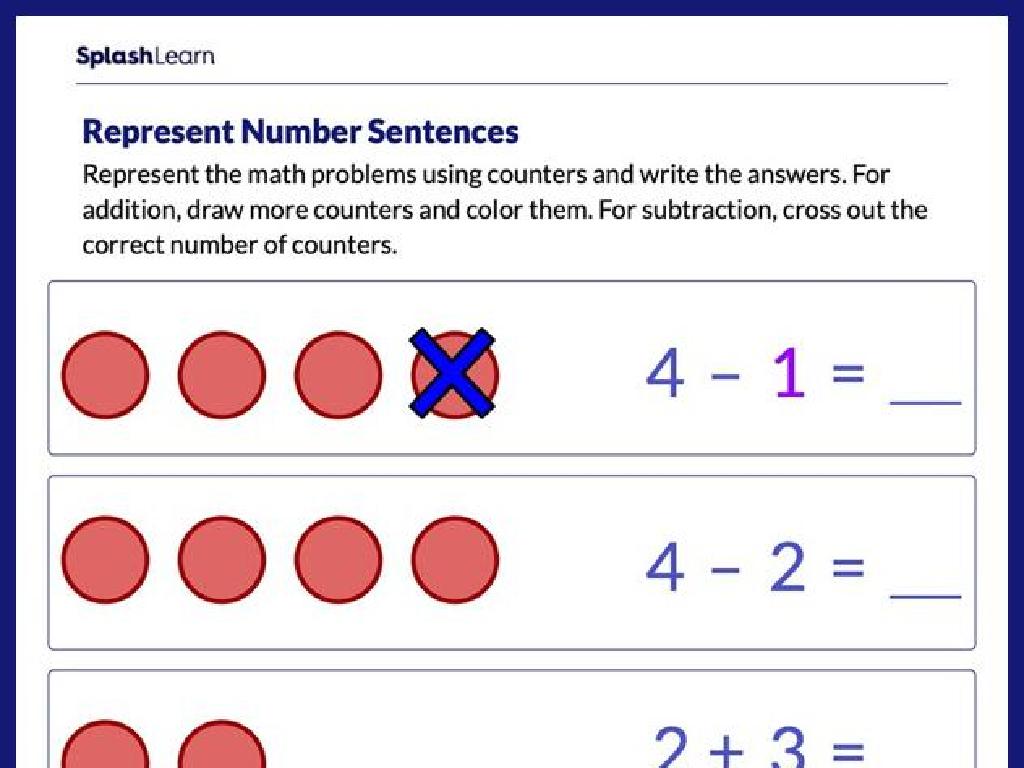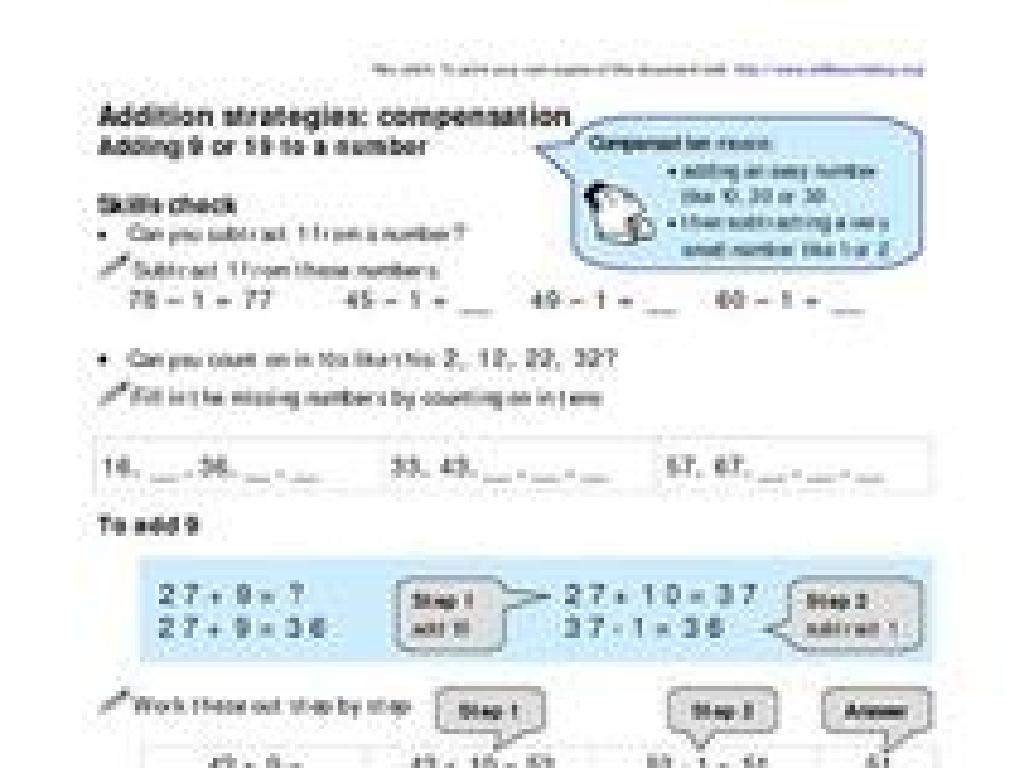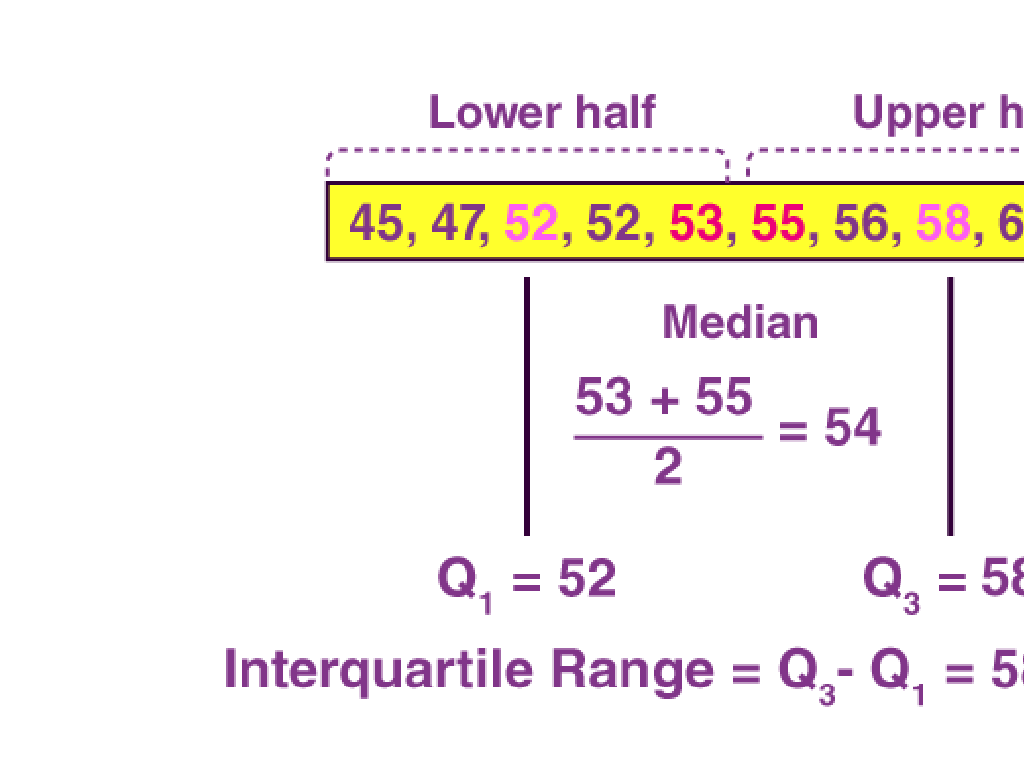Interpret Line Plots
Subject: Math
Grade: Seventh grade
Topic: Data And Graphs
Please LOG IN to download the presentation. Access is available to registered users only.
View More Content
Interpreting Line Plots
– Understanding line plot basics
– A line plot displays data along a number line with Xs above each value.
– Interpreting data on line plots
– Analyze the frequency of data points represented by Xs on the plot.
– Line plots in daily life
– Use in weather trends, class test scores, or tracking sports scores.
– Practice with real examples
|
This slide introduces students to the concept of line plots, a type of graph that is useful for displaying small sets of data. Start by explaining the structure of a line plot, including the number line and the use of Xs to represent data points. Emphasize the importance of interpreting the data correctly, which is a key skill in math and daily life. Provide examples of line plots from everyday scenarios, such as tracking temperatures or comparing scores in different subjects. Encourage students to practice by creating their own line plots using data from their own experiences or from class activities.
Understanding Line Plots
– Define a line plot
– A graph that displays data along a number line
– Key components of a line plot
– Includes title, scale, and distinct data points
– Real-life line plot examples
– Used in weather forecasting, economics, and science
– Analyzing data with line plots
– Helps in summarizing large data sets visually
|
A line plot is a simple and effective way to visualize data where frequency of the data is plotted. It’s important for students to recognize the components of a line plot: the title provides context, the scale indicates the units, and the data points represent the frequency of each value. Real-life examples include tracking temperatures over a week or comparing class test scores. Encourage students to think of other areas where line plots could be useful. In class, we can analyze sample line plots and discuss how they help us understand and interpret data quickly and efficiently.
Creating a Line Plot
– Collect all necessary data
– Data can be from surveys or experiments
– Select a suitable scale for the plot
– Scale must reflect the data range accurately
– Mark data points on the plot
– Each point represents a data value
– Connect points with a line
– The line shows trends or patterns
|
This slide guides students through the process of creating a line plot, a type of graph that is useful for showing trends in data over time. Start by gathering all the data you need, which could come from class surveys, scientific experiments, or other sources. Next, choose an appropriate scale for your graph; the scale should be consistent and reflect the range of your data. Then, plot your data points accurately on the graph. Finally, draw a line through your data points to help visualize any trends or patterns. Encourage students to practice by creating their own line plots with different sets of data to reinforce the concept.
Reading a Line Plot
– Identify the plot’s title and scale
– The title gives context; the scale shows measurement units.
– Comprehend each data point’s meaning
– Each point on the line represents a piece of data in context.
– Interpret the plot’s trend
– Look for patterns or changes over time in the data.
– Discuss the significance of the trend
– Understanding trends helps us make predictions or decisions.
|
This slide aims to teach students how to read and interpret line plots, an essential skill in data analysis. Start by examining the title of the plot, which provides a summary of the information displayed. Next, discuss the scale, which indicates the units of measurement and helps students understand the value of each data point. Students should learn to look at each point on the line plot to determine what it represents in the given context. Finally, interpreting the trend is crucial as it can show whether the data is increasing, decreasing, or remaining constant over time. Encourage students to think about why the trend might be significant in real-world situations, such as predicting sales or measuring growth. Provide examples of line plots for students to practice these skills.
Interpreting Line Plots
– Analyzing data on line plots
– Look for patterns, clusters, and gaps in the data
– Determine range, median, and mode
– Range is the spread of data; median is the middle value; mode is the most frequent value
– Drawing conclusions from data
– Use the data to make inferences about the population
– Class activity: Create your own line plot
– Use a set of data to draw a line plot and interpret it
|
This slide introduces students to the concept of interpreting line plots. Start by explaining how to analyze the data by looking for specific patterns or trends. Teach students how to find the range by identifying the smallest and largest values, the median by finding the middle value when the data is ordered, and the mode by determining which value appears most often. Emphasize the importance of drawing conclusions from the line plot, such as predicting trends or comparing groups. For the class activity, provide a data set for students to create their own line plots and practice finding the range, median, and mode. This hands-on activity will help solidify their understanding of the concepts. Provide guidance on how to accurately draw and label the line plot, and encourage students to share their conclusions with the class.
Let’s Practice: Creating Line Plots
– Create your own line plot
– Use the provided data set
– Use the data to plot points on a number line
– Share and discuss with a partner
– Explain your plot to your partner and listen to theirs
– Observe and interpret the results
– What do the data points tell us about the set?
|
This class activity is designed to provide hands-on experience with line plots. Provide students with a data set, perhaps measurements from a science experiment or survey results from the class. Students will use this data to create a line plot, marking the frequency of data points on a number line. After creating their plots, students will pair up to discuss their observations. Encourage them to consider questions like: What is the most common data point? Are there any outliers? What does the distribution of data points tell us? This activity will help solidify their understanding of line plots and how to interpret them. Possible variations for different students could include different data sets or adding additional questions for interpretation.
Real-World Application of Line Plots
– Line plots in various professions
– Used by economists, meteorologists, and more to analyze data trends
– Decision making with line plots
– Helps in forecasting and strategic planning across fields
– Class activity: Find line plots
– Look for line plots in news articles or weather forecasts
– Discuss the importance of line plots
|
This slide aims to show students the practical use of line plots in real-world scenarios. Professionals like economists use line plots to track changes over time, such as inflation rates, while meteorologists use them to display temperature changes. Understanding line plots is crucial for making informed decisions in various fields. For the activity, students will search for line plots in real-life sources such as news articles or weather reports, helping them recognize the application of what they learn in class. Teachers should prepare examples of line plots from different sources and guide students on how to interpret them. The activity will enhance students’ analytical skills and their ability to interpret graphical data.
Class Activity: Interpreting Line Plots
– Work in groups on a line plot
– Discuss observed trends
– Consider increases, decreases, or constants
– Prepare group findings
– Share with the class
– Each group will present their interpretation
|
This activity is designed to foster collaborative learning and enhance students’ analytical skills in interpreting data from line plots. Divide the class into small groups and provide each with a line plot. Encourage students to discuss within their groups the trends they notice, such as increases, decreases, or consistent patterns in the data. They should prepare a brief summary of their findings. After the group discussion, each group will share their insights with the class, allowing students to see different perspectives and interpretations of the same data. As a teacher, facilitate the discussion by asking probing questions and guiding students to notice subtle trends. This will also help students to articulate their understanding of line plots and how to interpret them.
Conclusion: Interpreting Line Plots
– Recap key concepts of line plots
– Review how to read and interpret data from line plots
– Understand line plots importance
– Line plots show frequency of data and help in making predictions
– Engage in Q&A for clarity
– Opportunity to ask questions and resolve any confusion
– Summarize today’s learning
|
As we wrap up today’s lesson on interpreting line plots, it’s crucial to revisit the main points. Emphasize the importance of line plots in displaying data in a clear, concise manner, which is especially useful in statistics and everyday problem solving. Encourage students to ask questions about any part of the lesson they may not have understood fully. This is an opportunity to address any misconceptions and ensure that each student is comfortable with the material. Conclude by summarizing the lesson, highlighting how line plots can be used to interpret data sets and the value they add to understanding real-world situations.
Homework: Interpreting Line Plots
– Find a line plot in media
– Write a paragraph on data interpretation
– Summarize what the data shows, trends, and any notable points
– Be prepared for class discussion
– Understand real-world data application
– Relate how line plots are used in everyday information sharing
|
This homework assignment is designed to help students apply their knowledge of interpreting line plots to real-world data. Students should look for a line plot in a newspaper or online, which could be related to weather changes, stock market trends, sports statistics, etc. They should write a paragraph interpreting the data, focusing on understanding the trend shown by the line plot and any outliers or patterns they can identify. Encourage students to think critically about what the data might imply and to be ready to discuss their findings in the next class. This will help them see the practical application of line plots and enhance their analytical skills.






